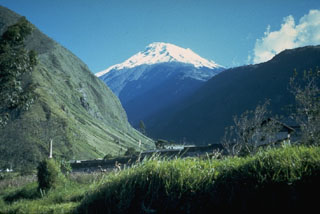Report on Tungurahua (Ecuador) — 1 December-7 December 2010
Smithsonian Institution / US Geological Survey
Weekly Volcanic Activity Report, 1 December-7 December 2010
Managing Editor: Sally Sennert.
Please cite this report as:
Global Volcanism Program, 2010. Report on Tungurahua (Ecuador) (Sennert, S, ed.). Weekly Volcanic Activity Report, 1 December-7 December 2010. Smithsonian Institution and US Geological Survey.
Tungurahua
Ecuador
1.467°S, 78.442°W; summit elev. 5023 m
All times are local (unless otherwise noted)
During 2-3 December, IG reported that Strombolian activity from Tungurahua was seen at night. Ash plumes on 3 December rose to an altitude of 8 km (26,200 ft) a.s.l. and ashfall was reported in nearby areas. On 4 December, a sudden increase in tremor detected by the seismic network was followed by intense roaring noises, an increase in the number and intensity of explosions, and window and ground vibrations. Pyroclastic flows descended the N and W drainages at 0939 and continued to occur in those and additional drainages until 1522, including Cusúa, Mandur, and Juive (NW), as well as Rea, Choglontús, and Mapayacu (SW). Ashfall occurred in uninhabited regions to the S and SE. According to news articles, people within 8 km of the summit were evacuated.
On 5 December, satellite images showed ash plumes drifting SW. Ashfall was reported in areas within 8 km SW, W, NNW, and NW. Explosions caused windows to vibrate. During 5-6 December, blocks ejected from Strombolian activity rolled 1 km down the flanks. On 6 December, ash plumes rose to an altitude of 8 km (26,200 ft) a.s.l. and drifted NW, W and SW, causing ashfall downwind. Gas-and-ash plumes on 7 December rose to altitudes of 7-8 km (23,000-26,200 ft) a.s.l. and drifted SW and W. Ashfall resulted in deposits up to 1 mm thick in areas to the W. Ejected blocks rolled 1-2 km down the flanks and explosions vibrated windows.
Geological Summary. Tungurahua, a steep-sided andesitic-dacitic stratovolcano that towers more than 3 km above its northern base, is one of Ecuador's most active volcanoes. Three major edifices have been sequentially constructed since the mid-Pleistocene over a basement of metamorphic rocks. Tungurahua II was built within the past 14,000 years following the collapse of the initial edifice. Tungurahua II collapsed about 3,000 years ago and produced a large debris-avalanche deposit to the west. The modern glacier-capped stratovolcano (Tungurahua III) was constructed within the landslide scarp. Historical eruptions have all originated from the summit crater, accompanied by strong explosions and sometimes by pyroclastic flows and lava flows that reached populated areas at the volcano's base. Prior to a long-term eruption beginning in 1999 that caused the temporary evacuation of the city of Baños at the foot of the volcano, the last major eruption had occurred from 1916 to 1918, although minor activity continued until 1925.
Sources: Reuters, Instituto Geofísico-Escuela Politécnica Nacional (IG-EPN)

